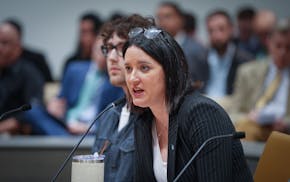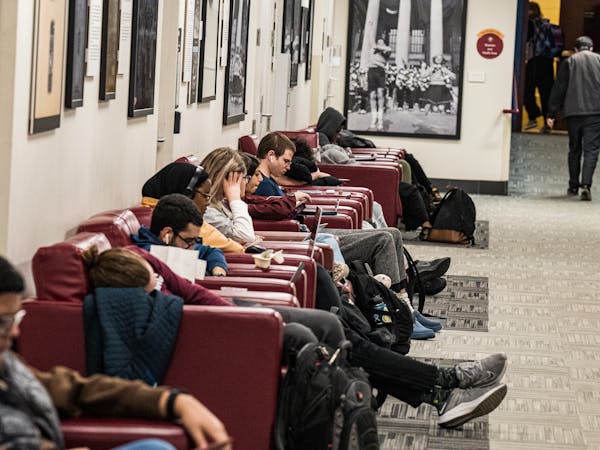The U.S. Supreme Court shook American higher education Thursday when it ruled that two universities that considered race as a factor in student admissions violated the Constitution, a decision that left many Minnesota colleges scrambling to figure out if they need to change their own procedures.
"Many universities have for too long wrongly concluded that the touchstone of an individual's identity is not challenges bested, skills built, or lessons learned, but the color of their skin," Chief Justice John Roberts wrote in the court's majority opinion, which threw out the admissions practices used at Harvard and the University of North Carolina. "This Nation's constitutional history does not tolerate that choice."
Justice Sonia Sotomayor, writing the dissenting opinion, accused her colleagues of rolling back decades of progress "based on their policy preferences about what race in America should be like, but is not, and their preferences for a veneer of colorblindness in a society where race has always mattered and continues to matter in fact and in law."
College administrators had been bracing for months for the decision, which came at a precarious time for many institutions. Recruiting is becoming more difficult as the pool of prospective students shrinks, due in part to changes in birth rates more than a decade ago. At the same time, the pool of students is also becoming more racially and ethnically diverse.
By 2036, about 40% of Minnesota public high school graduates will be people of color, according to projections by the Midwestern Higher Education Compact, a nonprofit that works with colleges and universities.
Affirmative action policies, which trace back to the 1960s, aim to improve education and employment opportunities for people of color. They had been challenged multiple times but largely upheld, with courts previously ruling that colleges could consider race as one of many factors in a holistic admissions process. Many Minnesota schools relied on past rulings to design the admissions procedures in place now.
In the hours after the ruling came down, many administrators sought to reassure students that schools will still find ways to promote diversity.
"It was certainly not surprising, and I can't even say it was disappointing because we expected it," Carleton College President Alison Byerly said of the ruling. "But I'll say it's regrettable that we are taking this step backward and being denied one of the ways we try to create diverse campuses."
Partisan reaction
The 6-3 ruling fell along the lines that have fueled concerns about partisanship on the nation's highest court. Joining Roberts in the majority opinion were justices Clarence Thomas, Samuel Alito Jr., Neil Gorsuch, Brett Kavanaugh and Amy Coney Barrett. Joining Sotomayor in the dissent were justices Elena Kagan and Ketanji Brown Jackson.
From the White House, President Joe Biden said he "strongly, strongly" disagreed with the court's ruling and urged colleges to seek other routes to diversity rather than let the ruling "be the last word."
In a social media post, former President Donald Trump, a Republican who is running again, called it "a great day for America."
"People with extraordinary ability and everything else necessary for success, including future greatness for our Country, are finally being rewarded," wrote Trump.
Former President Barack Obama, a Democrat and the nation's first Black president, issued a statement saying affirmative action allowed generations of students, including him and his wife, Michelle, to "prove we belonged."
"Now it's up to all of us to give young people the opportunities they deserve — and help students everywhere benefit from new perspectives," he said.
The ruling stems from a pair of lawsuits brought in 2014 by Students for Fair Admissions, a nonprofit that says "racial classifications and preferences in college admissions are unfair, unnecessary, and unconstitutional." The group argued that practices used at Harvard and the University of North Carolina did not provide the same benefits to Asian Americans as to other people of color, despite the fact they too have faced racial discrimination.
Both universities defended their practices, saying race was one of many factors they considered, they complied with past U.S. Supreme Court rulings, and they have researched other race-neutral models for admissions but have yet to find one that provides the diversity needed to enhance students' education.
The majority of justices rejected that argument, writing that because the universities' procedures "lack sufficiently focused and measurable objectives warranting the use of race, unavoidably employ race in a negative manner, involve racial stereotyping, and lack meaningful end points, those admissions programs cannot be reconciled with the guarantees of the Equal Protection Clause."
The ruling did not specify how universities should fulfill those requirements. It left open the possibility that colleges could consider information that applicants disclose "so long as that discussion is concretely tied to a quality of character or unique ability that the particular applicant can contribute to the university."
Reaction on Minnesota campuses
Many Minnesota colleges on Thursday began consulting with attorneys to interpret the ruling — a process they cautioned could take weeks or months.
The U.S. Department of Education has promised to provide guidance within 45 days. Many schools have already locked in classes for the fall but are beginning to recruit for future semesters.
Gustavus Adolphus College President Rebecca M. Bergman hopes their process will remain mostly intact.
"We have not largely considered race," Bergman said. "We are looking at factors like first-generation students. We recruit across the United States and internationally, and we're looking through a lot of different lenses on diversity."
Suzanne Rivera, president of Macalester College, said she believes the college's "holistic" admissions process can remain in place, particularly because applicants also often write about their identities and backgrounds in personal essays.
"I think this means that our diversity goals can still be achieved by what a student tells us about their lived experience," she said. "The challenge is how to ask the right questions and be discerning of the answers in order to achieve our diversity goals without running afoul of the court's decision."
Still, some Macalester students are concerned. Ahlaam Abdulwali, who is Somali and a graduate of Minnetonka High School, where she said she heard discriminatory statements from students and staff, took issue with the court's reasoning.
"All in all, the decision is ridiculous because it is based off the idea that racism doesn't exist or that the color of our skin doesn't matter," she said. "Racism and race is woven into the fabric of this country."
The Minnesota State system of colleges and universities, which enrolls about 300,000 students, didn't expect to be impacted. Spokesperson Doug Anderson said before the ruling that it doesn't use race as criteria for admissions.
Administrators at the University of Minnesota's Twin Cities campus, which enrolls about 55,000 people, told students they were still working to digest the ruling but "we remain steadfast in our commitments to our educational mission of inclusion and access."
In an interview before the ruling, Robert McMaster, vice provost and dean of undergraduate education, said the campus uses a holistic process. Admissions officers consider an applicant's grades, the rigor of their coursework and, to a lesser extent, test scores and class rank. They also consider "context factors," such as whether someone has outstanding musical talent, a commitment to community service, or a history of overcoming social, economic or physical barriers to complete their education.
Student leaders there are already trying to develop ways to implement new systems to ensure equal access to higher education, said Carter Yost, government and legislative affairs director for the undergraduate student government. They're also bracing for another ruling Friday, when the U.S. Supreme Court is expected to decide whether thousands of dollars in student loans can be forgiven.
"It's tense shoulders all around here," Yost said.
This story contains material from the Associated Press.

Lakeville teachers file intent to strike, picket outside school board meeting

Hennepin Co. Board OKs Mary Moriarty's request to hire outside lawyers for trooper prosecution

Under pressure, Minnesota legislators debate proposal to allow early marijuana growing
Two Forest Lake High School athletes hit by car, airlifted to hospital

